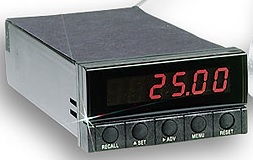
 This is about the wind speed indicator located in the operator's station at the top
of the Green Chair.
This is about the wind speed indicator located in the operator's station at the top
of the Green Chair.
Similar indicators (but without alarms) are located at:
The indicator for the Green Chair operator was originally requested by Mike Anderson (aka "Chipper") and installed in Jaunary 2007. He had found it useful to visit the First Aid Room to check the wind speed in high wind situations. In 2014 this indicator was removed due to lightning damage, and was not repaired until someone asked about it in late 2016. It was re-built and re-installed in January 2017.
Speaking of lightning: Unplugging this unit when there could be lightning would help prevent lightning damage. ( Hint ;-) This mainly includes Summer time, but lightning storms have occurred during the ski season (like March and April).
The indicator is not an official part of the chairlift control system. It is provided because it was thought to be a useful aid for the top operator.
When winds are steady, what it reads is pretty much what you are experiencing. When winds are gusty, depending on the wind direction, either you or the anemometer may experience a gust a few seconds before the other location feels it.
The indicator updates several times a second, allowing brief gusts to be measured. By contrast, the weather web site reports wind speeds which are one-minute averages. The weather station has no ability to record wind gust speeds.
Wind gust speeds are obviously higher than the average wind speed. Depending on the weather creating the wind, gusts can be a lot higher. The highest wind speeds seen have been about 105 miles per hour.
The indicator has two alarms, set for 40 and 46 MPH. When the wind speed exceeds these limits a red light (one for each of the limits) will illuminate next to the numeric readout. Audible alarms can also sound, but these can be individually muted with toggle switches on the front panel.
If winds are building, the audible alarms can be a reminder that things are getting interesting. Turn them off if/when they get annoying or you already know that the winds are strong. When winds ease-off consider re-enabling the audible alarms.
A "Test" pushbutton allows you to feed a simulated wind speed to the indicator. Along with a speed adjustment control, you can verify that the indicator works, and whether the visible and audible alarms work. It's also a way of getting to know what the alarm annunciator sounds like. Give it a try (no one outside of the lift shack will hear it).
At about 40 MPH, the wind can blow chairs around and start them swinging. If this happens near the bullwheel or a tower, a chair can be damaged.
At about 46 MPH, blowing the cable off the tower sheaves begins to be a concern.
Chair operation at higher wind speeds may be possible. The wind direction greatly affects how much wind speed is required to actually create a hazard. Exactly how much is a question for the lift maintenance folks. These limits were selected as speeds above which hazards begin to be a concern.
Gust wind speeds are just as hazardous as steady-state winds, but gusts allow much less time to react.
The indicator is not connected to the chairlift control system. It is intended to help you be aware of when dangerous conditions are developing.
You, and the bottom lift operator, need to understand the various safety issues, what to watch for, what precautions may allow restricted operations, and what conditions may require closure of the lift until high winds abate.

Unlike the other wind speed indicators, this model included two relay outputs related to the two set-point alarms. As such, it's a bit more expensive than the basic rate meter. None of the other wind speed displays have this alarm option.
This web page (URL = http://santiampassskipatrol.org/wx/weather11.htm) is on the weather station's web site, but no link is provided to it.
Feedback: To Bill Freund or
email
to " ".
".
- 1999 11/15 - Weather station, including wind speed sensor, installed
- 200x xx/xx - Wind speed displays for Ski Patrol installed
- 2007 01/xx - Wind speed display for Green Chair installed
- 2017 01/15 - Created this document, first-pass edits.
- 2017 01/21 - Second-pass edits.
- 2017 02/01 - A few more tweaks.
- 2018 09/08 - Added two more wind speed displays - Which have
their own web page.
(http://santiampassskipatrol.org/wx/weather12.htm)
- 2017 03/04 - Reviewed & tweaked a few words, but mainly to print new pages
for you (or the mice) to enjoy.